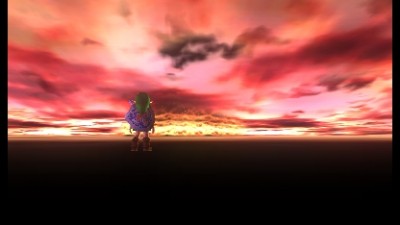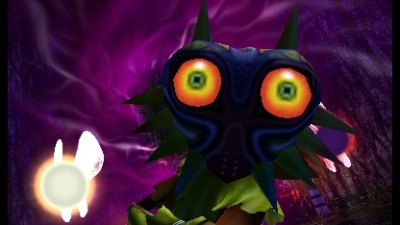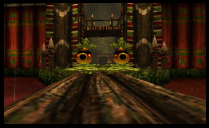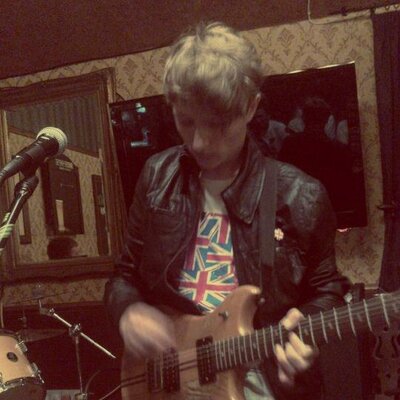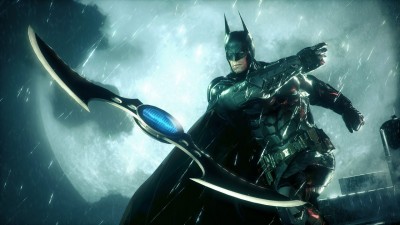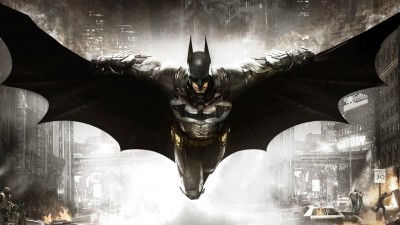Majora’s Mask for the 3DS is possibly the most anticipated remake Nintendo has ever released, even more so than Ocarina of Time 3D and The Wind Waker HD. Following the success of the Ocarina of Time re-release, fans clamored for a port of the game’s dark and weird N64 sequel. After years of teases and hints from Nintendo, it’s finally with us – and it is fantastic. A much-needed facelift complements some brilliant adjustments to the original design, and while some design changes don’t work as well as others, this fifteen year old classic has aged beautifully.
Majora’s Mask is a direct sequel to beloved Ocarina of Time. Link has left Hyrule in search of his fairy friend and guide from the previous game, Navi (God knows why). As he wanders through a gloomy forest he’s attacked by the mysterious Skull Kid, and has his Ocarina stolen in the process. A chase ensues, and Link is promptly transformed into a Deku Scrub. You’re told by the enigmatic (and equally mysterious) Happy Mask Salesman that if you can get your Ocarina back in three days, he can transform you back to normal. Thus, your quest in the bizarre land of
Termina begins proper. There’s something stressful about those first three days, as you’re thrown into a strange town, full of strange people, in a strange body, with no idea what to do or where to go. This move is intentional of course, as it encourages you to talk to the inhabitants of Termina, who make up some of the most memorable and affecting NPC’s in videogame history, and the new time-travelling structure of the game marks is as the most radical Zelda in the entire series.
You have to admire the balls Nintendo displayed by having you start the sequel to Ocarina of Time by playing as a completely altered version of Link. It’s a huge subversion of expectation, and this is something that continues throughout your quest.
Once you finally get back your Ocarina, and reach the end of your first three days, you’re introduced to the game’s most intriguing mechanic: Time Travel. See, as it turns out, Skull Kid wants to bring a very creepy-looking moon crashing down so he can destroy the world. There’s nothing you can do to stop him, so by playing your Ocarina you can go back in time three days to when you first entered Termina. You’ll still have your key gear, but all rupees, dungeon keys, and NPC interactions will be reset.
This is a genius piece of game design that ensures there are consequences besides a simple Game Over. Surprisingly, no one has ever attempted it since. If you fail to optimize your time in one three day cycle, you may have to run through a dungeon all over again, or begin a side quest from scratch. Thankfully, you can optimize your schedule with the Bombers Notebook, which documents the NPC’s you meet, and what time over three days they’ll be doing something you can help out with. There’s a lot of fun to be had in piecing together someone’s schedule over the three days, working out where they’ll be and what you can do to help. It’s a testament to the writing that you actually care about these characters, and become embroiled in their story. That you know they have only three days to live is a tragic side note, that adds pressure to continue on with your journey. Previous Zelda games had some great characters, certainly, but Majora takes it to a new level.
Majora’s Mask only has four main dungeons, only one of which is really great (Stone Tower Temple) and one of which really isn’t very good (Great Bay Temple). However, getting to each dungeon
involves extensive quests which are more memorable that the dungeons themselves. In the course of the main adventure, you’ll infiltrate a Pirate base to rescue Zora eggs, fight undead ninjas, and help reunite a Goron with his baby boy. The lack of dungeons is of little importance when the characters and side quests are so involving. Majora’s Mask is all about the journey - the destination is of little importance.
And what a journey you’ll have. Helping the various inhabitants of Termina will reward you with a series of masks, most of which don’t have much use outside of helping in the odd side quest, but the final reward for collecting them all is truly awesome. I won’t spoil it for you if you don’t know, but trust me… get all the masks before you face the final challenge. In addition to the masks, there are a ton of heart pieces to improve your health, a whole bunch of mini games including a shooting range, fishing, Goron racing, and so much more. Termina is a truly mysterious land (helped by the fact it’s never been seen before or since in a Zelda game) and you’ll want to explore every inch of it.
Time-travel structure aside, the core gameplay retains the tried-and-tested Zelda formula for the most part. Item-based progression and dungeons play out largely the same as Ocarina of Time, but the three key transformation masks help to keep things fresh. Through your adventure you’ll gain the ability to become a floating Deku Scrub, a super strong Goron, and an agile Zora at will. The new powers each mask gives you forces you to approach a lot of challenges differently than you might in a standard Zelda, with many of these abilities outright replacing classic items from the series, such as the Zora having detachable fins that work just like the boomerang. Sadly, there’s only one dungeon, the Stone Tower Temple, that really forces you to combine all three masks to make it through, and since that’s easily the best one, it’s a shame we don’t see more of that.
The graphics have of course, received a huge facelift. It may be 2015, but I’m still amazed you can cram an N64 game into a handheld console and have it look even better, not to mention in glorious glasses-free 3D. Improved textures, character models, and draw distance all serve to make Termina even more immersive than it was back in 2000 (and it was pretty bloody immersive back then). There’s no feeling quite like wondering through Termina, and looking up to see that menacing moon in the sky, getting ever closer to Clock Town… Boss battles also look better than ever, with some much needed changes made to the fights that make them more of a challenge and more fun to play. If anyone ever battled Gyorg, the giant fish from the Great Bay Temple, they’ll know it was a rubbish fight. This 3DS update has turned that disaster into a real battle.
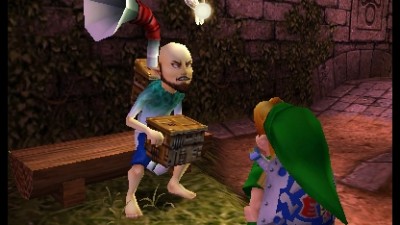 Frustratingly, there are a few niggles besides the disappointing dungeons, but nothing major if I’m honest. The Bomber’s Notebook is a little confusing at first, and very muddled up, making it tricky to navigate. Once you get used to it though, it becomes a useful resource that helps you keep track of everything you’ve discovered. Having to repeat the same three days over and over can sometimes become a touch annoying if you never finished a certain quest and have to repeat the whole thing again. And while there is plenty to do, the main quest is disappointingly short. A more difficult Hero Mode would also have been nice, especially after its inclusion on A Link Between Worlds and Wind Waker HD. However, for the most part, the 3DS optimizes and improves the experience, and the bite-sized nature of the game is perfectly suited to a handheld console.
Frustratingly, there are a few niggles besides the disappointing dungeons, but nothing major if I’m honest. The Bomber’s Notebook is a little confusing at first, and very muddled up, making it tricky to navigate. Once you get used to it though, it becomes a useful resource that helps you keep track of everything you’ve discovered. Having to repeat the same three days over and over can sometimes become a touch annoying if you never finished a certain quest and have to repeat the whole thing again. And while there is plenty to do, the main quest is disappointingly short. A more difficult Hero Mode would also have been nice, especially after its inclusion on A Link Between Worlds and Wind Waker HD. However, for the most part, the 3DS optimizes and improves the experience, and the bite-sized nature of the game is perfectly suited to a handheld console.
Majora’s Mask is a standout Zelda title that didn’t get the love it deserved the first time around, only to receive a greater appreciation of its experimental nature later on. If you’re looking for a game full of charm, with a fantastic story and tons of depth and invention, then The Legend of Zelda Majora’s Mask 3D is for you.
Fifteen years after gamers first stepped into the world of Termina, this 3DS remake feels like one of the freshest, experimental games money can buy.

